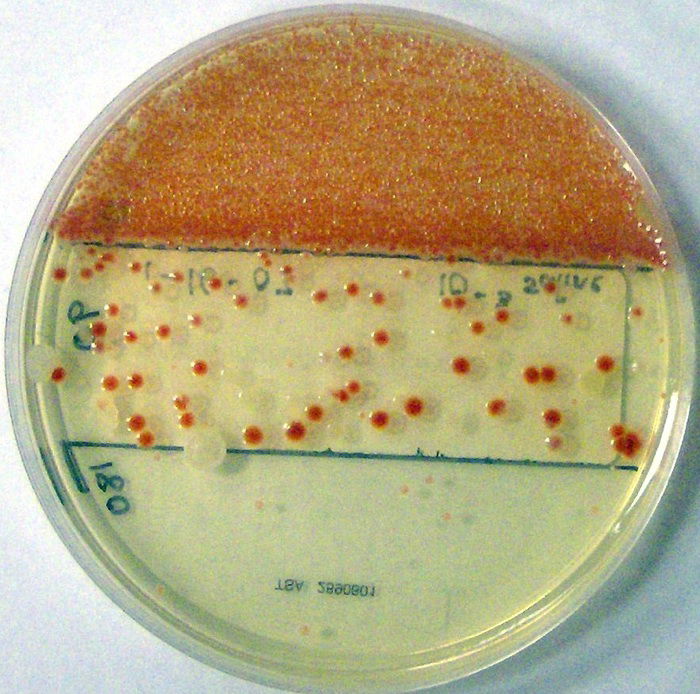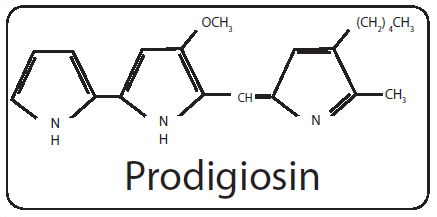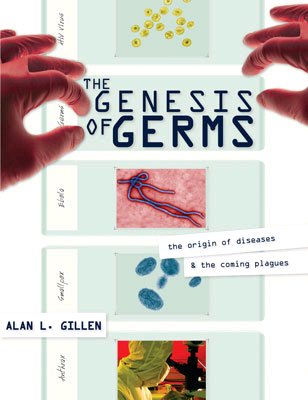
Chapter 1
Microbes by Design, Example 2, Serratia marcescens
Section 3
Another example of design which can be seen in the microbial world is the production of a blood-red pigment made by Serratia marcescens, the “miracle” bacillus. Serratia marcescens is a rod-shaped, facultative anaerobic bacterium. It is a Gram-negative bacillus in the family Enterobacteraciae. This common microbe is found on plants and in soil, water, and animals. Most microbiologists are all too familiar with S. marcescens, one of the most frequent contaminants of Petri plates in the lab. This brightly colored bacterium also grows well on food that has been stored in a damp place.
The pigment production by microbes can impart color to contaminated food. S. marcescens has a long history in the church, as well as in microbiology. S. marcescens has a fondness for growth on starchy food-stuffs (e.g., bread and communion wafers), where the pigmented colonies have been mistaken for drops of blood. Indeed, in numerous historical incidents, the red pigment produced by Serratia marcesens growing in bread has been interpreted as a sign of blood.
Historical Focus 1.2
The “Blood of Christ” and the History of a Red Mystery

Blood-Red and White Mutants of Serratia marcescens. Alan L. Gillen image.
The history of Serratia goes back to the 6th century B.C., when Pythagoras reported on the blood substance that sometimes appeared on food. Then, in 332 B.C., soldiers of the Macedonian army of Alexander the Great found that, from time to time, their bread appeared to have blood on it. The Macedonian soldiers interpreted these bizarre phenomena as evidence that blood would soon flow in the city of Tyre and that Alexander would win. Later in the Christian tradition, since the time of the Middle Ages through the Renaissance periods, it was regularly observed to grow on communion wafers. This led many to think this was the blood of Christ, hence a miracle. For example, in the dark, damp churches of medieval times, sacramental wafers used in Holy Communion often became contaminated with S. marcescens. On more than one substance, the “blood” on it was thought to be a miracle. One such event inspired the artist Raphael to paint his awe-inspiring masterpiece, the Mass of Bolsena. In 1263, four hundred years before Anton van Leeuwenhoek would observe bacteria under a microscope, a blood-like substance appeared on the communion bread.
The German priest Peter of Prague is shown breaking bread for communion at the Church of Saint Christina in Bolsena, Italy. When the famous priest broke the communion wafer, he thought that it had blood on it and that the bread had truly become Jesus’ flesh! In 1264, to honor of the miracle of Bolsena, Pope Urban instituted the feast of Corpus Christi (“Body of Christ”). Neither the pope nor Peter the priest could ever have known that a red bacterium, Serratia marcesens, was the probable cause of this blood-like substance on the communion bread.
An important stimulus to the early development of microbiology came with attempts to discredit an infamous, alleged miracle. Bartholomeo Bizio, an Italian pharmacist from Padua, Italy, discovered and named S. marcescens when he identified the bacterium as the cause of a miraculous bloody discoloration in a cornmeal mush called polenta. He looked at the red spots under a microscope and saw what he described as a fungus. (Terms like fungus and virus were often used in the early microbiological literature to describe what we now classify as bacteria.) In 1817, he moistened some bread and polenta and left them in a warm, damp atmosphere. Twenty-four hours later, both the bread and polenta were covered in red growth. In 1819, Bizio named Serratia in honor of an Italian physicist named Serrati, who invented the steamboat. Bizio chose marcescens from the Latin word for decaying because the bloody pigment was found to deteriorate quickly. By 1823, he named the organism Serratia marcescens.
The Prussian microscopist Christian Gottfried Ehrenberg (1795–1876) also showed an interest in the red spots found on “bloody bread,” and in 1848 he inoculated them onto potatoes, bread, and Swiss cheese kept in metal vessels, the atmosphere of which was kept moist with damp paper. In so doing he may have been the first person to cultivate bacteria. Ehrenberg is also likely to have been the first to use the term bacteria (meaning little rods). In 1836 he had described “infusoria” and named a number of bacteria, including Bacterium and Spirillum.
Irreducible Complexity of Prodigiosin Production
Serratia is most noted for its bright red pigment called prodigiosin. Over the years, it has certainly gotten the attention of churchgoers and scientists alike. It also is one of the few bacteria that produces bright pigments, and it comes in a variety of colors, including red, white, pink, and purple. Its color variation was noted as early as 1888. The first person to describe the biosynthesis of this pigment in the late 1940s was Dr. Robert P. Williams, a Christian microbiologist. His interests in Serratia were many, including what controlled the expression of the red phenotype in S. marcescens. Pigment production in Serratia is influenced by several variables, including temperature, nutrient media, and exposure to ultraviolet (UV) light.

Chemical structures of prodigiosin
Some strains of S. marcescens are capable of producing prodigiosin, which ranges in color from dark red to pale pink, depending on the temperature, substrate, and age of the colonies. Most strains of S. marcescens are red under 27 ºC (80.6 ºF) and white above 28 ºC (82.4 ºF). (Pigment and flagella production stops at approximately 28 ºC.) The synthesis of prodigiosin is an irreducibly complex process. An irreducibly complex system is one that requires several interlacing parts to be present at the same time, where the removal of one or more parts causes the whole system to malfunction. Destroy one part and the whole system falls apart. In evolution, a new trait would have to be completely developed, no halfway measures would do. Given this requirement, new features are so complex that Darwinian gradualism is very improbable because an incompletely developed trait would offer no selective advantage.
Prodigiosin, a linear tripyrrole, is synthesized in a bifurcated pathway, in which mono- and bipyrrole precursors are synthesized separately and then coupled to form the red pigment (above). (There are parallels in the way blood clots form—think of dominos in a Y formation—one falling upon and after another.) Prodigiosin is a secondary metabolite, which is constructed from several amino acids that may accumulate in the cell as a result of primary metabolism. The terminal stop in prodigiosin biosynthesis is by the condensing of the mono- and bipyrrole components and is temperature sensitive. Proline is incorporated intact in the prodigiosin molecule, histidine is used indirectly, methionine contributes a methyl group, and alanine is entirely incorporated except for a carboxyl group.
Prodigiosin Pigment Offers Protection
The functions of pigment have long been pondered, but only recently determined. Many texts say that there is no known function for prodigiosin. In the past, ideas range from prodigiosin associated with flagellar production to the enhancement of the aerosolization of S. marcescens, and the formation of prodigiosin allows the cell to remove toxic accumulation of metabolites such as amino acids. It appears that prodigiosin offers protection for Serratia in the natural environment. The red pigment offers protection against excessive UV in sunlight and serves as an antibiotic and has cytotoxic qualities. It appears that it is worth the energy investment to synthesize prodigiosin when it serves protection against UV light and when it has to compete with fungi in the soil and uses its red pigment as an antibiotic against neighboring molds.
Disease Focus 1.3
Serratia Is an Opportunistic Pathogen
Only since the 1960s have microbiologists recognized S. marcescens as an opportunistic human pathogen. In the hospital, Serratia tends to colonize the respiratory and urinary tracts of adults, rather than the gastrointestinal tract. Serratia causes about two percent of nosocomial infections of the bloodstream, lower respiratory tract, urinary tract, surgical wounds, and skin and soft tissues of adult patients. Outbreaks of S. marcescens meningitis, wound infections, and arthritis have occurred in pediatric wards. In most cases, Serratia infections have occurred in people who have compromised immune systems or those who are aged.
The Creator’s Signature, “Red-Lettered” Bacteria
So maybe S. marcescens was not the miracle that the pope expected, but this tiny organism does remind us of the wondrous invisible life that is all around. The pigment from Serratia may not be the blood of Christ, but it does in fact have a brilliant, blood-red color that attracts attention, and its natural production of variable bright colors testifies of the Creator’s artistic abilities. When viewed in the Petri dish, or up close, it is a highly attractive microbe. Finally, ability of the bacterium to produce the pigment and adapt under varying environmental conditions suggests the Sustainer’s foreknowledge of S. marcescens’ need to survive.
The Creator formulated not only the plan for S. marcescens, but also produced the first working organisms. He is not only the Chief Architect of the red pigment, but is also the manufacturer of the prodigiosin components. He keeps everything going because He is the Maintainer. The predictable color of the prodigiosin at lower temperatures exists because the order of the precise plan was produced by an intelligent cause. These finely tuned and interdependent interactions are examples of what biochemist Behe calls irreducible complexity. It cannot be explained by Darwinian evolution. Most creation biologists would go a step further and say that it is clear, physical evidence of fingerprints from the Master’s hand. Although an alleged miracle of communion, the blood of Christ may not have appeared as the church once declared; however, Serratia is still the miracle bacillus. The “miracle” is that an awesome artist would care enough to sustain and protect even His tiniest creations. He has left His signature on it—one of red-lettered importance.
The Genesis of Germs
Professor Alan Gillen shows that constantly mutating diseases are proof for devolution rather than evolution.
Read OnlineRecommended Resources

Answers in Genesis is an apologetics ministry, dedicated to helping Christians defend their faith and proclaim the good news of Jesus Christ.
- Customer Service 800.778.3390
- © 2024 Answers in Genesis



